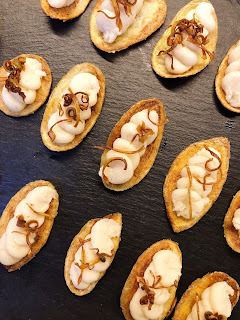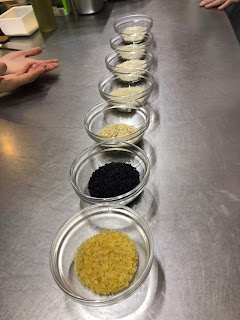Sono Italiana Lunch & Conclusion of Southern Cuisine
Today we held our second lunch at the Castello for outside guests. This time, my group was in charge of the pass horderves and the appetizer. We decided to create the horderves based on the ideas of what we learned in class.
The first was a fried potato chip with a fava bean puree and fried artichoke. These 2 flavors go very well together and as a group, we felt it represented the top 3 things we felt was seen most in what we learned.
The second was called Sciatt, a fried buckwheat cheese ball. We changed the cheese because we felt the original did not melt well and that it did not have a strong flavor. We chose a cheese that was stronger and brought forward more flavor.
Our main appetizer represented the simple cuisine of Italy and the lightness of the dishes of Puglia. We had a poached sea bream on a garlic and sponsali (sort of green onion) puree, mussels, fresh veggies, dehydrated fish skin, and a parsley foam. This was a simple dish that was very delicate, but flavorful.
I would also like to use this blog to conclude the time in the kitchen cooking the different cuisines of Southern Italy. Although it is near impossible to put the cuisines of the regions together, something important I saw amongst them all was the use of fish in their dishes. From Puglia to Sicily and everything in between, fish is important to many regions. The use of pigs and sheep are also important, but they are often cooked in a simple way. The inners of these animals are traditionally used, as the meat was made into salume and sold for money. Unlike some of the northern regions, there is the importance of boarding regions in the south. In Abruzzo there is the Transumanaza that ends in Puglia. There is also the area of Umbria, Abruzzo, and Marche were there is the importance of the pig. Here are more of my notes on each of the different regions of the south:
- Sicilia: This region has strong flavors with things like eggplant, red sauces, eggs, cheese, pasta, and pine nuts. Couscous is seen served with fish in this region, proof of the influence of the Arabs. There are stuffed fish and meat, that are very hearty and filling. Lemon, olive oil, and capers finish these dishes. There are a lot of sweets prepared within this cuisine.
- Sardegna: Wild arugula, tomatoes, capers, onions, and lots of citrus are very important to this region. Dishes are finished with white wine, pecorino cheese, saffron, and vinegar. There is a lot of one pot cooking done in this cuisine. Almonds, walnuts, and raisins are also seen in a lot of dishes.
- Calabria: This region has a very spicy cuisine. It uses vegetables like eggplant, onion, mushrooms, green peppers, and others in their dishes. Beans, chickpeas, and pasta are important caloric pieces as well. The use of bay leaves, oregano, and peperoncino are important as well.
- Basilicata: Mushrooms, broccoli rabe, artichokes, and tomatoes are seen throughout. This is a poor region with a lot of one pot dishes. As the preparations are simple, spices are very important, including cinnamon, cloves, and peperoncino.
- Lazio: Mint grows wild in this region and is pairs well with mushrooms. There is a large Jewish influence on the cuisine. Tomatoes parsley, garlic, and rosemary are used throughout the dishes. Vegetables are very important, with broccoli rabe as a front-runner. Raisins and pine nuts are also used in the traditional dishes from this region.
- Campania: This region has about the same about of traditional meat and fish dishes. The cuisine is both healthy and flavorful with a lot of vegetables used in the dishes. The herb of the region: parsley!
- Umbria: This is a very hilly and mountainous region with only a small amount of flat lands in the middle of the region. Rive fish is used here as it is landlocked, which creates a different flavor in the dishes created with it. Farro and lentils are used for the caloric benefit as they are important to the economy of the region. There is not a lot of vegetables used compared to the other regions, but cardoons are used.
- Abruzzo & Molise: This cuisine is flavorful with a lot of vegetables used. The meat used most here is sheep and pig from the high mountains. The cuisine is very hearty with a lot of pasta and polenta, caloric foods.
With love,
Baylee







Comments
Post a Comment